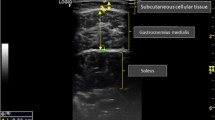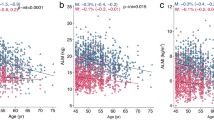Abstract
Background
Muscle thickness and echo intensity measured using ultrasound imaging represent both increased muscle volume and connective tissue accumulation. In combination, these ultrasound measurements can be utilized for assessing sarcopenia in community-dwelling older adults.
Aims
This study aimed to determine whether morphological and qualitative characteristics classified by quadriceps muscle thickness and echo intensity measured using ultrasound are associated with muscle strength, physical function, and sarcopenia in community-dwelling older adults.
Methods
Quadriceps muscle thickness and echo intensity were measured using ultrasound imaging in 1239 community-dwelling older adults. Latent class analyses were conducted to classify participants based on similarity in the subcutaneous fat thickness (FT), quadriceps muscle thickness (MT), subcutaneous fat echo intensity (FEI), and muscle echo intensity (MEI), which were assessed using ultrasound imaging.
Results and discussion
Morphological and qualitative characteristics were classified into four types as follows: (A) normal, (B) sarcopenic obesity, (C) obesity, and (D) sarcopenia type. Knee extension strength was significantly greater in A than in B and D. FT and percent body fat were greater in C than in the other types. The correlation between the ultrasound measures and knee extension strength differed among the classification types. The classification types were significantly associated with sarcopenia prevalence.
Conclusions
Classification of the morphological and qualitative characteristics obtained from ultrasound imaging may be useful for assessing sarcopenia in community-dwelling older adults.

Similar content being viewed by others
References
Cruz-Jentoft AJ, Baeyens JP, Bauer JM et al (2010) Sarcopenia: European consensus on definition and diagnosis: report of the European Working Group on Sarcopenia in older people. Age Ageing 39:412–423
Lauretani F, Russo CR, Bandinelli S et al (2003) Age-associated changes in skeletal muscles and their effect on mobility: an operational diagnosis of sarcopenia. J Appl Physiol 95:1851–1860
Rantanen T, Avlund K, Suominen H et al (2002) Muscle strength as a predictor of onset of ADL dependence in people aged 75 years. Aging Clin Exp Res 14:10–15
Newman AB, Kupelian V, Visser M et al (2006) Strength, but not muscle mass, is associated with mortality in the health, aging and body composition study cohort. J Gerontol A Biol Sci Med Sci 61:72–77
Seals DR, Washburn RA, Hanson PG et al (1983) Increased cardiovascular response to static contraction of larger muscle groups. J Appl Physiol Respir Environ Exerc Physiol 54:434–437
Abe T, Loenneke JP, Thiebaud RS (2015) Morphological and functional relationships with ultrasound measured muscle thickness of the lower extremity: a brief review. Ultrasound 23:166–173
Rech A, Radaelli R, Goltz FR et al (2014) Echo intensity is negatively associated with functional capacity in older women. Age (Dordr) 36:9708
Wilhelm EN, Rech A, Minozzo F et al (2014) Relationship between quadriceps femoris echo intensity, muscle power, and functional capacity of older men. Age (Dordr) 36:9625
Strasser EM, Draskovits T, Praschak M et al (2013) Association between ultrasound measurements of muscle thickness, pennation angle, echogenicity and skeletal muscle strength in the elderly. Age (Dordr) 35:2377–2388
Watanabe Y, Yamada Y, Fukumoto Y et al (2013) Echo intensity obtained from ultrasonography images reflecting muscle strength in elderly men. Clin Interv Aging 8:993–998
Cadore EL, Izquierdo M, Conceição M et al (2012) Echo intensity is associated with skeletal muscle power and cardiovascular performance in elderly men. Exp Gerontol 47:473–478
Ikezoe T, Asakawa Y, Fukumoto Y et al (2012) Associations of muscle stiffness and thickness with muscle strength and muscle power in elderly women. Geriatr Gerontol Int 12:86–92
Fukumoto Y, Ikezoe T, Yamada Y et al (2012) Skeletal muscle quality assessed from echo intensity is associated with muscle strength of middle-aged and elderly persons. Eur J Appl Physiol 112:1519–1525
Ticinesi A, Meschi T, Narici MV et al (2017) Muscle ultrasound and sarcopenia in older individuals: a clinical perspective. J Am Med Dir Assoc 18:290–300
Fujiwara Y, Suzuki H, Kawai H et al (2013) Physical and sociopsychological characteristics of older community residents with mild cognitive impairment as assessed by the Japanese version of the Montreal Cognitive Assessment. J Geriatr Psychiatry Neurol 26:209–220
Kera T, Kawai H, Yoshida H et al (2017) Classification of frailty using the Kihon checklist: a cluster analysis of older adults in urban areas. Geriatr Gerontol Int 17:69–77
Watanabe Y, Hirano H, Arai H et al (2017) Relationship between frailty and oral function in community-dwelling elderly adults. J Am Geriatr Soc 65:66–76
Ohara Y, Hirano H, Watanabe Y et al (2013) Masseter muscle tension and chewing ability in older persons. Geriatr Gerontol Int 13:372–377
Chen LK, Liu LK, Woo J et al (2014) Sarcopenia in Asia: consensus report of the Asian Working Group for Sarcopenia. J Am Med Dir Assoc 15:95–101
Wannamethee SG, Atkins JL (2015) Muscle loss and obesity: the health implications of sarcopenia and sarcopenic obesity. Proc Nutr Soc 74:405–412
Muthen B (2004) Latent variable analysis: growth mixture modeling and related techniques for longitudinal data. In: Kaplan D (ed) The sage handbook of quantitative methodology for the social sciences. Sage, Thousand Oaks, pp 345–368
Baumgartner RN (2000) Body composition in healthy aging. Ann N Y Acad Sci 904:437–448
Nishihara K, Kawai H, Hayashi H et al (2014) Frequency analysis of ultrasonic echo intensities of the skeletal muscle in elderly and young individuals. Clin Interv Aging 9:1471–1478 (eCollection 2014)
Overend TJ, Cunningham DA, Kramer JF et al (1992) Knee extensor and knee flexor strength: cross-sectional area ratios in young and elderly men. J Gerontol 47:M204–M210
van Holsbeeck M, Introcaso JH (1992) Musculoskeletal ultrasonography. Radiol Clin North Am 30:907–925
Fridén J, Sfakianos PN, Hargens AR et al (1988) Residual muscular swelling after repetitive eccentric contractions. J Orthop Res 6:493–498
Nosaka K, Clarkson PM (1996) Changes in indicators of inflammation after eccentric exercise of the elbow flexors. Med Sci Sports Exerc 28:953–961
Zhang Y, Jordan JM (2010) Epidemiology of osteoarthritis. Clin Geriatr Med 26:355–369
Manini TM, Hong SL, Clark BC (2013) Aging and muscle: a neuron’s perspective. Curr Opin Clin Nutr Metab Care 16:21–26
Akazawa N, Okawa N, Tamura K et al (2016) Relationships between intramuscular fat, muscle strength and gait independence in older women: a cross-sectional study. Geriatr Gerontol Int. doi:10.1111/ggi.12869
Acknowledgements
We are grateful to the local authorities of the Itabashi Ward and the elderly people who participated in this study. We would like to thank Jung Songee, PhD, from the University of Tsukuba, who is currently with the National Center for Geriatrics and Gerontology, for the support in the muscle echo intensity measurement. This study was supported by JSPS KAKENHI (24700774) and a Health and Labor Sciences Research Grant (H23-Choju-Ippan-001, H23-Choju-Ippan-002).
Author information
Authors and Affiliations
Corresponding author
Ethics declarations
Conflict of interest
The authors declare that they have no conflict of interest.
Ethical approval
All procedures performed in studies involving human participants were in accordance with the ethical standards of the institutional and/or national research committee and with the 1964 Helsinki declaration and its later amendments or comparable ethical standards.
Informed consent
Informed consent was obtained from all individual participants included in the study.
Rights and permissions
About this article
Cite this article
Kawai, H., Kera, T., Hirayama, R. et al. Morphological and qualitative characteristics of the quadriceps muscle of community-dwelling older adults based on ultrasound imaging: classification using latent class analysis. Aging Clin Exp Res 30, 283–291 (2018). https://doi.org/10.1007/s40520-017-0781-0
Received:
Accepted:
Published:
Issue Date:
DOI: https://doi.org/10.1007/s40520-017-0781-0




